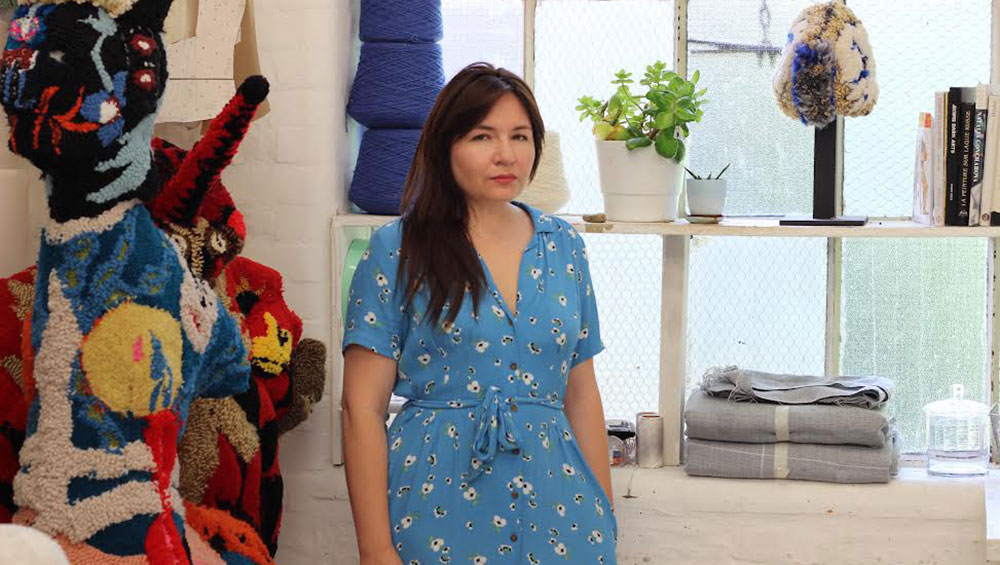
Anna Perach. Photo courtesy the artist.
by SABINE CASPARIE
Anna Perach is one of the lucky ones. She was hoping to get a studio space at Gasworks in Vauxhall for a while, and in 2021 one became free. “Studios are so hard to come by in London, and there are only five spaces here,” she tells me while making me a coffee in the Gasworks kitchen, where a large table is set for a lunch to welcome the new artists in residence. “But then I got a call that there was one available. I thought I was coming for an interview, but instead they showed me around and welcomed me straight away. I was beyond myself – it was a huge step up for me. For the first time, I had enough space for professional equipment and yarns so the space itself really pushed my practice forward. And it feels like family here.”
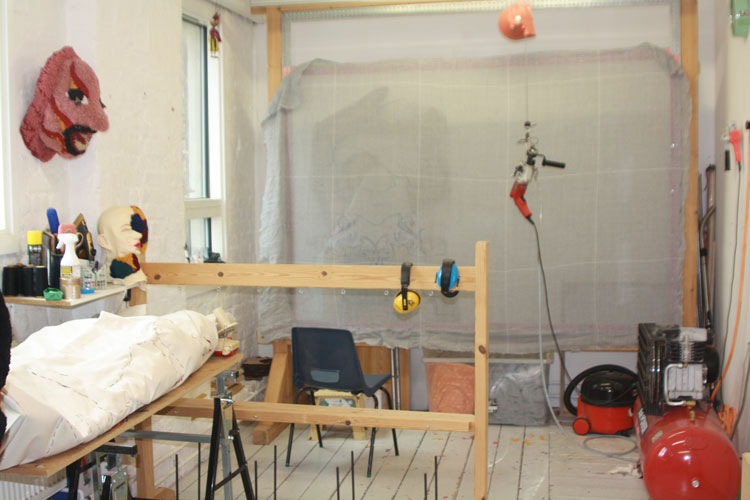
Anna Perach's studio.
Her studio is spacious, with three big east-facing windows. On one side is a large tufting frame, a machine she bought when she moved into this larger space; the tufting gun she used to make her fabric pieces is dangling from it. Next to it, on the other wall, is a shelving unit full of coloured yarns, faced by the final result – one of Anna’s wearable sculptures. I sit on a chaise lounge in the corner, facing Anna at her desk, the sunlight streaming in. A large book lies open. Perach’s work has always been research heavy and I am curious about what she is currently reading. “I am looking into the 18th century, at pre- and post-Enlightenment,” she tells me. “Like everything it started off as an intuition, but the more I read, the more I understand what interests me about that period. There was a tension: the beginning of the separation between the natural and the industrial worlds, the development of science, the disbelief in magic. This particular book, The Female Thermometer by Terry Castle, looks at the time period from a feminine angle. The concept of ‘the uncanny’ was written and talked about a century before Sigmund Freud made it famous, and Castle imagines the whole 18th century rooted in uncanny practices and imagery. For example, she writes about the thermometer as a scientific invention that quickly becomes used as a metaphor for female desire in the eyes of the patriarchal establishment.” Perach laughs. “And the rising of the temperature can also be seen as a phallic symbol.”
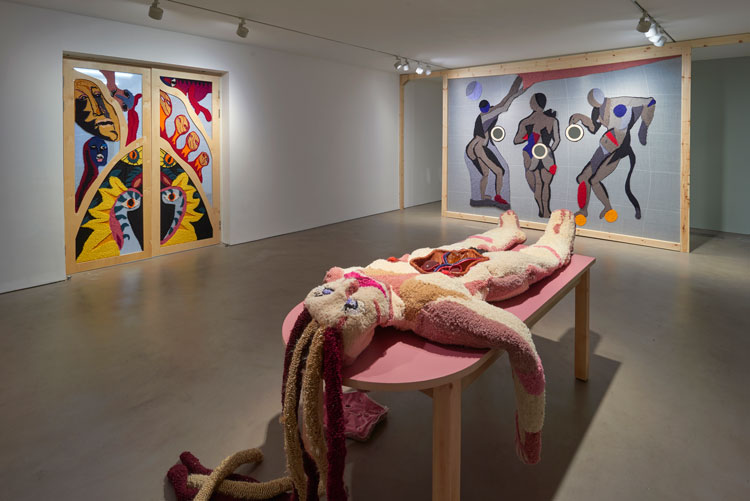
Anna Perach, Holes, 2024. Exhibition view. Commissioned and produced by Gasworks. Photo: Andy Keate.
I tell Perach that it reminds me of Hettie Judah’s words in her Guardian review of Perach’s show Holes at Gasworks earlier this year. I quote: “The rich colours, fuzzy surfaces and curvy forms of these works invite touch. I want to rub my hands across Perach’s works, nuzzle into them, embrace them – but they are also monstrous, often concealing claws or teeth.” What is it about that dissonance between the softness of her work and the underlying darkness that appeals to her? “I just like stories,” she says. “They are a basic way for me to process things.”
Perach completed a degree in art therapy and counselling after having worked in a communal house for adolescents with mental health issues. “I am thinking a lot about how you can communicate complicated nuance and emotional narratives, how you can be both very honest and direct but also make others connect. You can cover something difficult with something visually attractive and enticing.” She is currently reading a book of Greek mythology with her eight-year-old son. “It’s all about murder and incest. I want my kid to be mindful of the moral discrepancy between mortals and gods, to make sure the behaviour that’s described does not become normalised. There is a large number of taboos in these stories and I am interested to look at them via the Id superego, the Freudian structure of the self. For my practice, I wonder how direct can I be with the content I share? How much do I need to entice with “beauty” and when does it become my own processing of traumatic experiences and ideas? I am always searching for that magical ingredient.”
,-2022.jpg)
Anna Perach, Mother of Monsters (Blue), 2022. Courtesy the artist.
Perach’s wearable sculptures are like colourful costumes that recall the Slavic imagery and decor with which she was surrounded when she grew up in Ukraine, then still part of the Soviet Union. How does she see the relationship between mythology and folklore? “Folklore is the tradition, a physical element that helps people to practise their beliefs. Folklore connects us to the lineage of previous generations and thus, for me, creates a sense of grounding. Although I was seven when I left Ukraine, my parents maintained the life they had there within the house I grew up in, the food they cooked, and the stories they read to me. I read folktales about Russian tsars and tsarinas. It was a different time then. We didn’t speak Ukrainian, for example, and the social norms were determined by the Soviet Union. There were a lot of restrictions on what people could say in the public sphere and there was a deficit in basic food products: I remember my parents queuing for bread. I think that’s where my attraction to magical realism comes from: the desire for magic in the sadness and greyness of the everyday.”
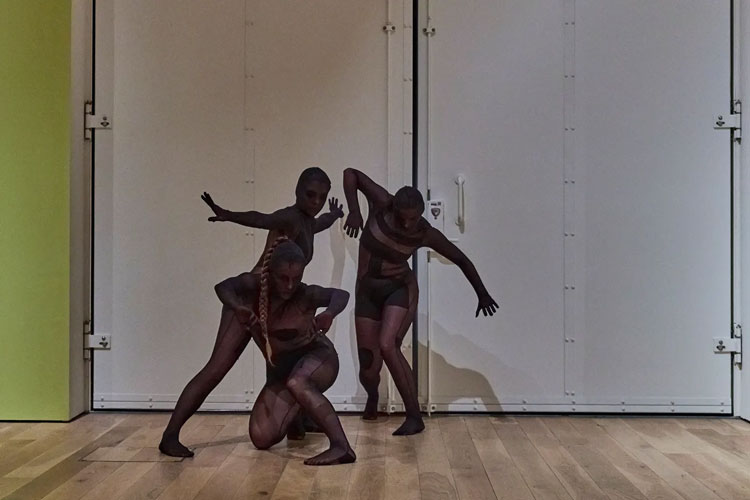
Anna Perach, Performance Ecstasies, 2024 at Material Worlds, Mead Gallery. Photo: Luke Pickering.
The theatrical element from folklore reappears in Perach’s performances. I tell her that I sometimes feel that artist performances come across as a little unfinished, amateurish even, but not Perach’s. I found Ecstasies, the performance related to her exhibition Holes, incredibly accomplished. “Thank you,” she says. “I don’t perform myself and I really love collaborating with others. I owe the end result of the performance to the conversations and labour of the movement and sound experts I work with. For Holes, I worked with movement director/choreographer Luigi Ambrosio. I began working with him when I felt quite lost giving instructions to performers. I really trust him, and his movement vocabulary is now part of how I think about performance. He used to be a dancer with different companies and had done some choreography, and people who come from dancing are much more used to working in a group.” Perach also found a great musical director, Laima Leyton, whom she adores, and she was happy to find that Leyton and Ambrosio got along really well too. “I had to give up some control at times, but I felt that their bonding through work was extremely important to the performance.”
I ask who else she looks at for inspiration. “I am inspired by artists such as Rebecca Horn and Sharon Eyal. Performance as a medium within the arts has its own traditions, and I love the spectacle – I would love to do a performance on the stage. In my ideal world, I would have a theatre company and would be able to work with and pay my performance team all the time. That is my absolute fantasy. “Like Diaghilev?” I ask. “Yes! I love Diaghilev.”
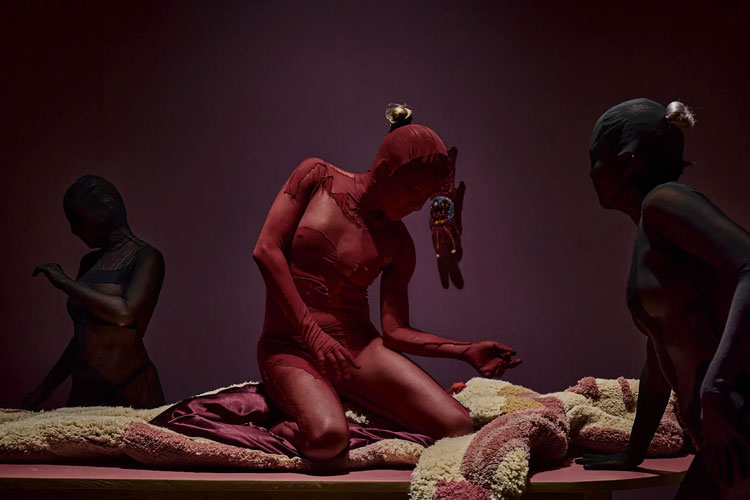
Anna Perach, Performance Ecstasies, 2024 at Material Worlds, Mead Gallery. Photo: Luke Pickering.
Perach’s performances and sculptures take the female body as their starting point. Does she consider herself a feminist? Perach hesitates. “I struggle with the term, as people put different content into it. Taylor Swift is a feminist, for example, and I don’t know if my ‘brand’ of feminism is the same as hers! If you are asking what tradition do I belong to, I definitely consider myself part of a lineage of women artists who look at the female body and question the social roles of that body.” Can she imagine herself rendering a male body or a trans body, I wonder. “I am using the body more as a metaphor. I am very interested in the tension between fluidity and restriction, in forms that are filled and evacuated. I explore that through the feminine body, which is my own body – the one I know the best. There are similar conversations occurring in queer and transgender communities, but I feel it’s not my place to speak for those experiences. I do hope that my practice creates the sense of an ally.”

Anna Perach, Venus, 2023. Exhibition detail of Holes. Commissioned and produced by Gasworks. Photo: Andy Keate.
In Perach’s performance Ecstasies – of which there were two, one at the Victoria & Albert Museum and one as part of the exhibition Material Worlds at Mead Gallery – the central sculpture is a giant female figure made of tufted fabric, based on the concept of the “Anatomical Venus”. “During the Enlightenment every scientific and medical discovery was based on the white, male body, which became the norm. The female body goes through hormonal fluctuations and thus gives less-clear results, and it was positioned as the abnormal and monstrous. The 18th century Anatomical Venus was a medical device: it was the western idealisation and sexualisation of female beauty, with full lips and wide hips, embellished with pearls, and always carrying a little foetus inside her. In Holes, my version of Venus also has a foetus inside, exposed in her abdomen, and during the performance a real woman emerges from inside her tufted skin. It is like a rebirth, but also something that is being expelled.” Like that film that’s just come out, The Substance? I ask. “Yes! I really want to go see it!” She turns more serious now. “I feel we are in this period of transition: everything we created since the Enlightenment, all those systems come crashing down. The progress we made is blowing up in our face: hyper-capitalism, global warming. I think there is a lot of imagery of things coming out of things.”
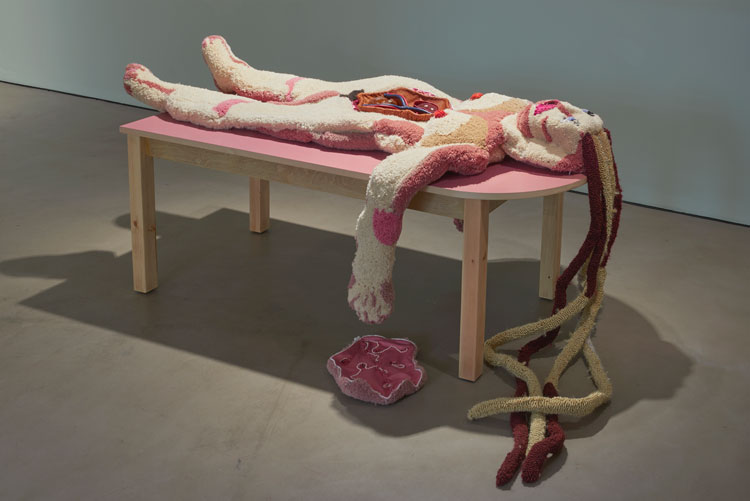
Anna Perach, Venus, 2023. Exhibition detail of Holes. Commissioned and produced by Gasworks. Photo: Andy Keate.
We have talked so much about the ideas underlying Perach’s work that I almost forget to ask her about the most obvious thing: her tufted fabric. Her use of the material started from a very personal space; she grew up with a Soviet aesthetic where the floors and the walls of homes are covered with carpets: for warmth, insulation and decor. When her family moved to the south of Israel when she seven, her parents kept those carpets on the floor even if they lived in the desert. “It was a projection of their internal world. I was interested in that strangeness of the carpet material: hairy and animal. It is mechanised but also troubling in a way.” Perach studied sculpture and theatre in Israel, and only became interested in using the carpets when she did her MFA at Goldsmiths 10 years ago. She tried making works with existing carpets first, pieces that she cut up and reassembled, but felt it did not fully work. “I thought: what if, instead of appropriating cultural objects, I just make my own? I did embroidery first, which is the same principle of piercing fabric and creating knots. Tufting is that process on a larger scale.” Was it frowned on at Goldsmiths? “No, not really, although textile wasn’t as popular as it is now.”
We walk to her tufting frame and she gives me a small demonstration. The thread is wound around a fabric gun, which is a drill-like tool, and shot through the screen from the back. It is a surprisingly violent process for a result that looks so soft. “The process is repetitive and I find it very calming,” Perach says. “This is a medium I have control over.” She realises that her work is often seen through the tradition of textile, used by many female artists but often regarded as less interesting because it was a craft material, associated with the domestic. “It’s another lens, and I get it. But I really just love the material; I started using it before I understood the tradition.”
What’s next? Perach is one of the artists in the show Material Worlds, which has just opened at the Mead Gallery in Warwick and will later tour around the country. Her work is also part of the group show Infinite Woman at Fondation Carmignac in the south of France. Perach shows me images from a beautiful catalogue, her sculptures of maternity corsets. She will be doing a performance there when the exhibition closes at the end of November. “I will be bringing the maternity corsets alive under Louise Bourgeois’s Spider! I usually do not place my performances in close proximity to other work, as it gets distracting, but that is a premise I am really excited about.”
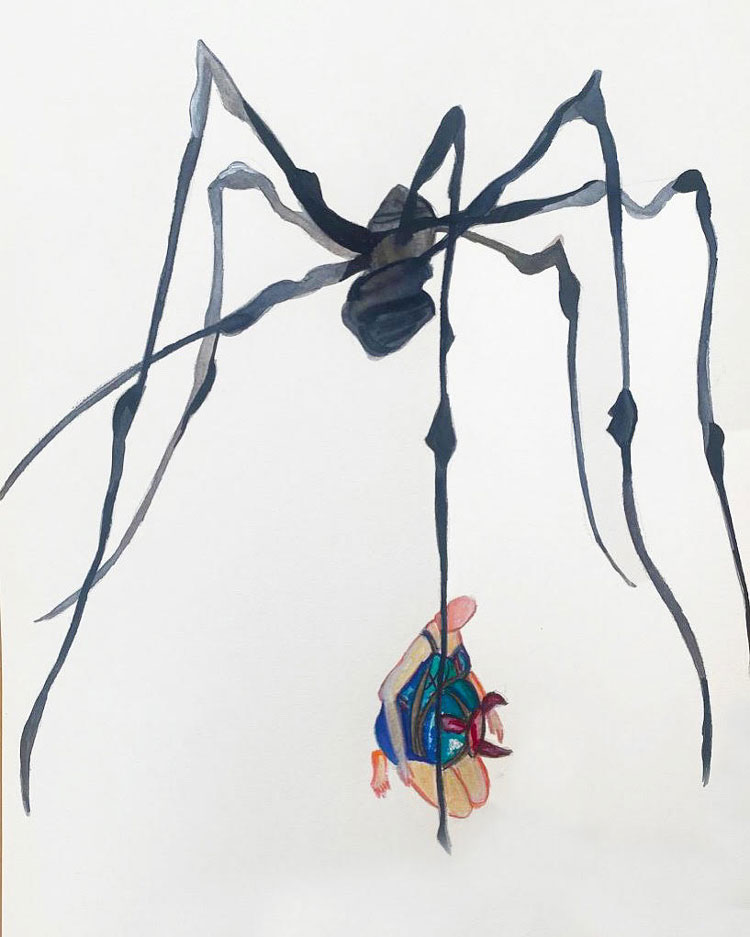
Anna Perach, Mother of Monsters, 2024. Watercolour (sketch for Performance at Fondation Carmignac).
We come back to the psychology and the darkness that underlies Perach’s and Bourgeois’s work. Bourgeois had therapy all her life but felt that it was through her creative practice that she could really process her emotions. Is that the same for Perach? “The processing stage for me happens during the early stages, my research and the sketches. When it comes to the sculptures and the performance, I take a more managerial role.” Thinking back on Ecstasies, I can attest that nothing of those psychological feelings gets lost; quite the contrary. Perach has an incredible ability to delve into our most intimate and deepest fears, secrets and desires, and feed them back to us while sweeping us away with an entrancing spectacle. It’s almost uncanny.
• Anna Perach’s work can be seen in The Infinite Woman, at Fondation Carmignac, Porquerolles Island, Var, France, until 3 November, and in Material Worlds: Contemporary Artists and Textiles, at Mead Gallery, University of Warwick Art Collection, until 15 December.